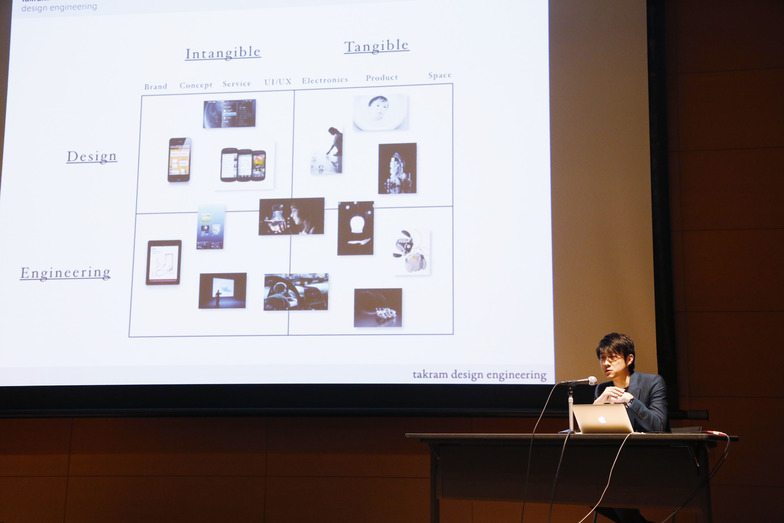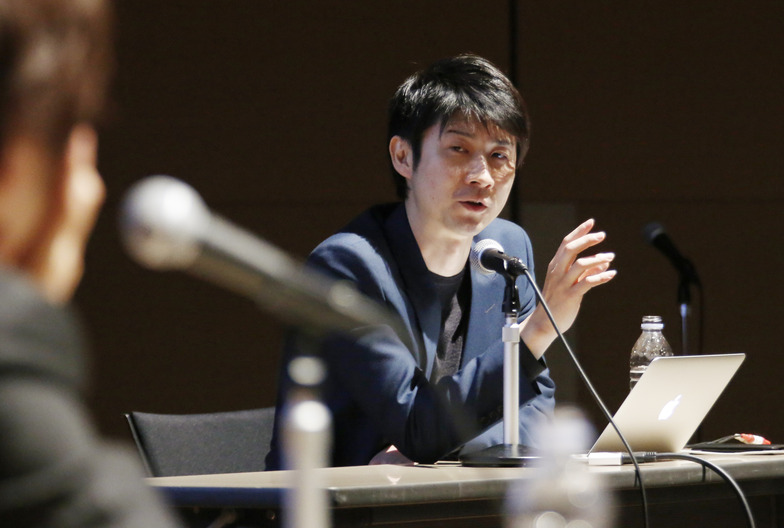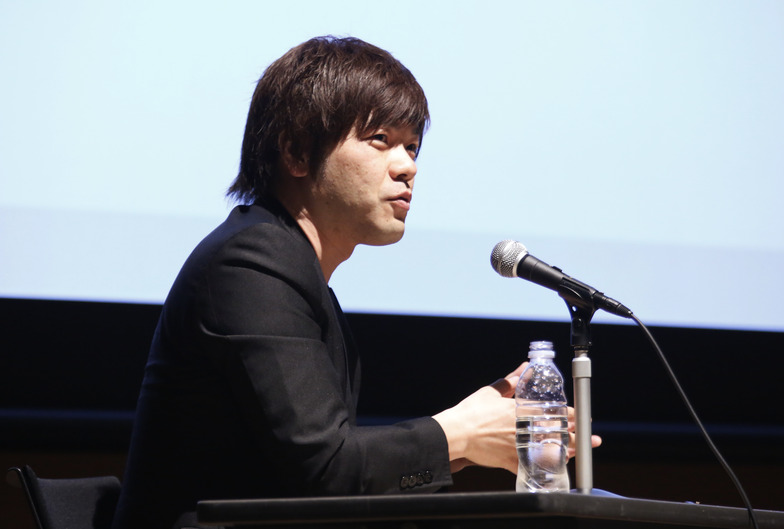The March 27th Dentsu Inc. Design Talk featured writer Keiichiro Hirano and design engineer Kinya Tagawa. Hirano's recently proposed "Dividualism" posits that humans do not live solely as one individual personality, but possess distinct diviuals for each interpersonal relationship, living as a collective of these. Meanwhile, the design engineering firm "takram," led by Mr. Tagawa, adopts a methodology where a single person switches between and combines the approaches of "design" and "engineering" during development. Though their fields differ, the two share common ground in their underlying perspectives.
We present their dialogue on "storytelling" and "craftsmanship" in two parts.
There is no boundary between design and engineering
Tagawa: takram is a design engineering company. While it's not uncommon for designers and engineers to work in teams, the people at takram are those who gained engineering experience before entering the world of design—individuals who possess both skills within themselves.
We call them "design engineers." Both as individuals and as a company, we aim to intervene in various areas—from products to user interfaces, from service design to conceptual work—while avoiding getting stuck in any single domain.

Let me introduce some recent work.
"Taste of Light," exhibited in France, was designed from the imagination of what a device might be like if humans could taste light in the future.
"Shenu," exhibited at the "Design of Activity" exhibition in Roppongi Midtown, explored the theme of Earth's environment 100 years from now. Set in a future where nuclear contamination drastically reduced drinking water, it presented five organs designed for a body that pseudo-evolved to no longer require water. We've also handled art direction for the children's science program "Mimikuriz" on NHK Educational TV.
Hirano: I myself wrote about the problem of securing water in a closed environment during a round trip to Mars in my novel "Dawn," but I never thought of replacing the bladder (laughs). How are these artistic endeavors positioned within takram? Do you separate them from design work?
Tagawa: Within one person, I switch between an artistic mindset and a design mindset depending on the project, adapting to each situation.
Hirano: At takram, is it difficult to work if you can't do both design and engineering?
Tagawa: The boundary between design and engineering becomes increasingly blurred, especially in cutting-edge fields. There isn't a clean dividing line to begin with. For example, when designing a desk leg, an engineer looks at it from the perspective of strength, while a designer looks at the beauty of its form and balance. Their languages are different, but the parameters they're actually dealing with are the same. Even an engineer, if they gain design experience, can develop a designer's perspective alongside an engineer's perspective within about three years if they're quick to grasp things. It's not about fusion, but more like swinging a pendulum between the two perspectives.
What lies at the interface between artifacts and humans?
Hirano: It's fascinating how design and engineering overlap without being divided. I believe products ultimately connect to some part of the body. If it's something you touch, it connects to the hand (tactile sense); if it's something you see, it connects to the eye (visual sense). Even as smartphones evolve to become smaller and lighter, they inevitably must connect to the hand. Therefore, they must maintain a certain size.

Tagawa: The discussion of physicality is inseparable from our work. In the movie "2001: A Space Odyssey," there's a scene where the ape awakens to using a bone as a tool. That represents the excitement of a living creature first grasping a tool—it's almost the same kind of excitement we felt when we first held an iPhone. It's the intense pleasure of experiencing an extension of one's own physicality. If we broadly consider the concept of tools as extensions of bodily functions, we start to view humans and tools as a single integrated system. Design then becomes about achieving the best possible harmony between them.
However, since artifacts and humans cannot fuse, an "interface" emerges at that boundary. As Mr. Hirano mentioned earlier, design must engage with the five senses precisely because those senses reside at that boundary.
There's also the term "interaction," but I've come to feel it's a slightly outdated concept. That's because interaction is "inter + action." In other words, the unit of measurement is "action." But the sensation of swiping your finger across an iPhone, that suction-like pull on your finger mid-motion—that feels like a connection between machine and human at a finer granularity than a single action. I believe the iPhone was accepted precisely because that felt so natural and fresh. It's less about action and more akin to a sense of "balance" or "equilibrium." Achieving that well-balanced state has become one perspective when designing.
Hirano: I once did a sci-fi thought experiment. If humanity vanished from Earth, could aliens from another planet imagine the human body based on the artifacts left behind? Artifacts are structured based on the body. Cities are the inverse of the human body. Products like stairs and handrails correspond one-to-one with parts of the body.
But no matter how long you gaze at nature, it never makes you picture the human body. Whether an iPhone powers on or has a signal makes an enormous difference in the amount of information we get about human form. I believe the human body also has a design engineering mechanism.
Because humans are creatures of the endocrine system, where the five senses are controlled by secretions. It's a system where dopamine is released to feel happiness, or adrenaline is released to feel excitement.
It's fundamentally a reward system. I'm sure that eventually, we'll conceive of systems where artificial objects and the body's endocrine system directly stimulate each other, without needing physical interfaces like hands or feet.
Is "Observation" Objective? The Pitfalls of User Research
Hirano: When designing things, Mr. Tagawa, do you visualize specific users? What's the most crucial factor then?
Tagawa: How to understand users is actually the area where the clearest answers are hardest to find. People often say you should create personas, but some designers can start working once they have a persona, while others freeze up the moment they create one.
The mainstream design thinking approach today is based on "observation." Observation means placing the justice or correctness of design not in the designer's subjectivity, but in the environment itself. However, for designers who aren't particularly skilled at this, having that sense of justice reclaimed by the individual can actually make it easier to create things that people truly enjoy.
Hirano: That's when the individual's subjectivity aligns with something societal. You could call it the genius type.
Tagawa: Exactly. Humans are strange creatures. In ethnographic research, the moment people realize they're being observed by a designer, they start trying to be a "persona" or a "user." They begin acting out some kind of non-existent self-consistency (laughs). To practice truly advanced ethnography, you have to eliminate the awareness of being observed to the absolute limit. But humans are complex; everyone carries some form of internal division. Even with advanced observation, you can't create something that addresses that entire complex situation. Ultimately, choosing which angle to focus on involves subjective insight. Design methods using observation can superficially appear to embody some kind of justice, so those employing the method must handle it with care.
I believe we've entered a phase where the justice residing within the individual is being reevaluated. Even if it stems from personal subjectivity, if one can effectively access the networks of interest on the internet, they can now gain support and financial backing from people who resonate with and empathize with that sense of justice. Crowdfunding is a prime example. Therefore, creators can now develop their own sense of justice and effectively leverage such situations to create things. Within this context, I think designers are increasingly required to possess a sense of balance between objectivity and subjectivity, observation and insight.
You can also read the interview here on AdTae!
※Part 2 will be released on Saturday, May 2
Planning & Production: Aki Kanahara, Dentsu Inc. Event & Space Design Bureau










